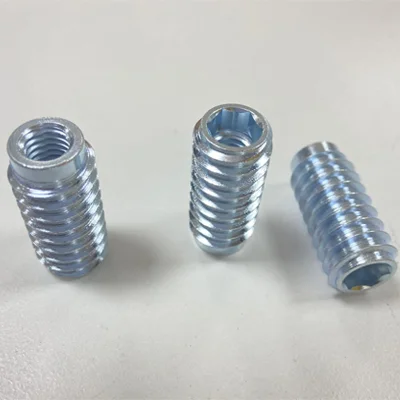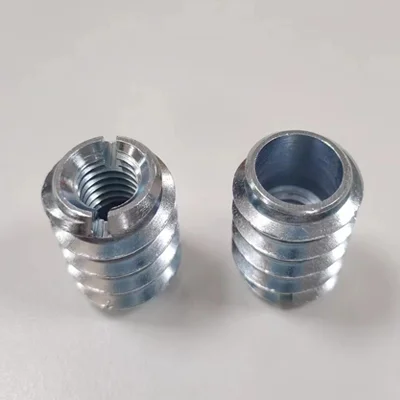caTEGORIES
Tags
What Are the Key Advantages of Threaded Inserts in Metal Fabrication?

Posted: July 18, 2025
Categories: News
Threaded inserts are super cool for making metal projects stronger. They help spread out weight, fight wear, and keep threads tough, especially in tough or rusty places. Let’s find out how these tiny but awesome parts make fasteners more reliable, make fixes easier, and fit special needs for big jobs like cars, planes, and machines.

How Do Threaded Inserts Enhance Strength and Load Capacity in Metal Projects?
Why Are Threaded Inserts Essential for Reinforcing Internal Threads in Metal Components?
When you work with metal parts, especially ones with heavy loads, the threads inside can be the weakest spot. Threaded inserts fix this by acting like a strong shield inside holes. They spread weight over a bigger area and give deeper threads. This makes the connection super strong.
This is really important for soft metals like aluminum or magnesium. Their threads can wear out fast when you tighten them a lot. Inserts make a tough layer that protects the metal from breaking. They also let you put in and take out fasteners many times without hurting the threads.
How Do Threaded Inserts Improve Load Distribution in High-Stress Applications?
In tough places like airplane frames, car parts, or big machines, spreading weight evenly is a big deal. It stops cracks from forming in one spot. Threaded inserts help by sharing pulling and pushing forces across the metal. This lowers stress at the thread roots and makes things last longer.
Some inserts with twisty coil designs act like springs. They soak up shakes and bumps, keeping your project safe from breaking over time.
What Options Are Available for Heavy-Duty Metal Assemblies?
If you need strong solutions for tough jobs, check out threaded inserts made for heavy work. QEWIT offers awesome FASTENERS of general grade, high grade, and ones made of Brass/Copper, Stainless Steel, aluminum, and alloys. These inserts give super strong pulling power and come in stainless steel for extra toughness.

How Do Threaded Inserts Improve Wear Resistance Over Time?
Can Frequent Assembly/Disassembly Damage Threads? Here’s How Inserts Help
Threads can get worn out when you put parts together and take them apart a lot. Each time you tighten a fastener, it rubs the threads, especially in soft metals. This can make them loose or even break.
Threaded inserts fix this by giving a tough thread layer that wears out way slower than regular metal threads. Their strong build stays good even after tons of tightening and loosening.
What Makes Threaded Inserts Ideal for Harsh Industrial Environments?
Tough places like chemical plants or ocean rigs can make metal parts rust or wear out fast. Stainless steel threaded inserts are great here because they fight rust and stay strong.
QEWIT works hard to make top-quality products. Their stainless steel inserts are built for long-lasting use in rough spots like chemical plants or offshore platforms.
Can Threaded Inserts Simplify Repairs and Maintenance?
How Do You Restore Damaged or Stripped Threads Without Replacing Entire Components?
One of the best things about threaded inserts is fixing broken or worn-out threads without throwing away big parts. You just drill out the bad hole and put in an insert. This makes new, strong threads fast and cheap.
This trick is used a lot in repairs where you can’t stop work for long but need things to stay super strong.
Why Is Quick Installation Important for Reducing Downtime?
In busy factories or quick field fixes, every second counts. A good insert system lets you put them in fast with simple tools, often without moving the part.
QEWIT gives helpful tips to pick quick-install twisty inserts. These make thread fixes precise and keep your work going smoothly.
Can You Use Threaded Inserts on Thin-Walled or Soft Metals?
How Do You Achieve Strong Threads in Aluminum, Magnesium, or Lightweight Alloys?
Thin metal parts or soft metals like aluminum or magnesium are tricky. They don’t have enough room for strong threads and can bend when tightened. Threaded inserts solve this by making a tough thread layer without needing deep holes in the metal.
This makes them perfect for things like boxes, brackets, or cases where the metal is thin but needs to stay strong.
What Prevents Deformation During Fastening in Lightweight Structures?
Without extra help, tightening into thin metals can make them bulge or crack. Inserts spread the force over a bigger area, keeping the metal’s shape and strength.
For light projects that need to be strong but not heavy, check out ThinWall Series inserts. They’re made for thin metal walls. QEWIT can make special fasteners based on your drawings or samples.
Can Threaded Inserts Adapt to Complex Designs and Custom Requirements?
Are There Solutions That Support Complex Geometries or Tight Tolerances?
Modern projects often have tricky shapes that regular fasteners can’t handle. Precision threaded inserts can be made with different lengths, sizes, or special locks to fit tight spots in complex projects.
This makes them super important for things like airplane parts or medical tools where everything has to be exact.
What If Your Project Requires Custom Sizes or International Standards?
Whether you need metric (ISO), unified threads (UNC/UNF), or special sizes for your project, custom threaded inserts are super flexible. QEWIT offers extra work to meet your special needs.
With over 30,000 product lines, you can order lots of items from one place. This makes buying easy and works for projects all over the world.
If you want a trusted partner for standard or custom threaded insert solutions, connect with QEWITCO FASTENERS CO., LTD. They started in 2004 with British roots and work in places like China, Taiwan, Malaysia, Vietnam, and Thailand. QEWIT is a reliable supplier of top-quality Fasteners & Fixings & Other Industry Consumables. Their team gives expert help and great service to make your project easy and worry-free.
FAQ
Q1: Can threaded inserts be reused after disassembly?
A: Yes! Most strong threaded inserts can be used many times without wearing out, especially ones made from stainless steel or tough alloys.
Q2: What tools are required to install threaded inserts?
A: You need simple tools like drill bits to make holes bigger, tap sets to make threads, and insertion tools (hand or powered) depending on the insert type—twisty coil, solid body, or self-tapping kinds.
Q3: Are there threaded insert options suitable for plastic as well as metal?
A: This article talks about metal, but many companies make special threaded inserts for plastics too, like heat-set ones. Picking them depends on the plastic’s heat and hardness.


